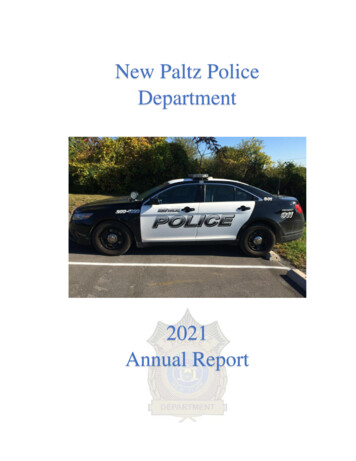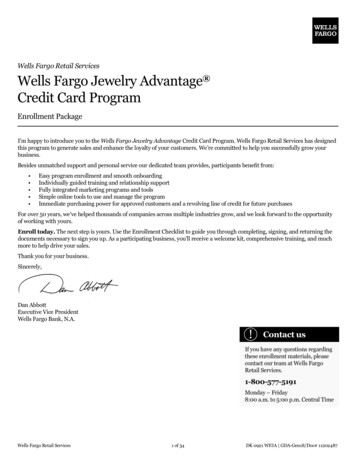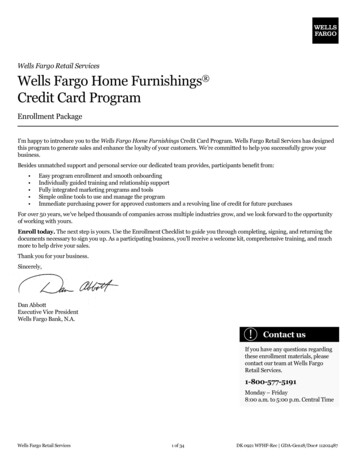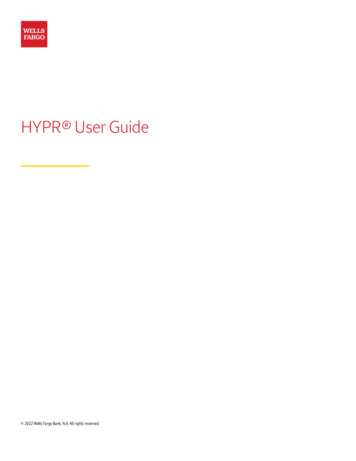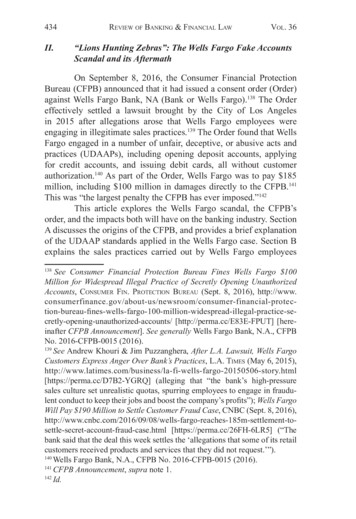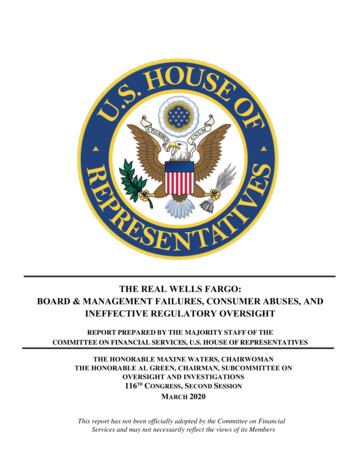
Transcription
THE REAL WELLS FARGO:BOARD & MANAGEMENT FAILURES, CONSUMER ABUSES, ANDINEFFECTIVE REGULATORY OVERSIGHTREPORT PREPARED BY THE MAJORITY STAFF OF THECOMMITTEE ON FINANCIAL SERVICES, U.S. HOUSE OF REPRESENTATIVESTHE HONORABLE MAXINE WATERS, CHAIRWOMANTHE HONORABLE AL GREEN, CHAIRMAN, SUBCOMMITTEE ONOVERSIGHT AND INVESTIGATIONS116TH CONGRESS, SECOND SESSIONMARCH 2020This report has not been officially adopted by the Committee on Financial1Services and may not necessarily reflect the views of its Members
Table of ContentsExecutive Summary . 4I.Introduction . 6II.Background on Wells Fargo . 9III.The Committee Staff’s Investigation .14A.1.2016 Sales Practices Consent Orders. .152.2018 Federal Reserve Consent Order. .183.2018 Compliance Risk Management Consent Orders. .19B.IV.Consent Orders .15Key Wells Fargo Board Members & Senior Executives .21Committee Staff Findings.23A.Before the 2016 and 2018 Consent Orders, Financial Regulators Knew AboutSerious Enterprise-Wide Deficiencies at Wells Fargo for Years Without Alerting thePublic .231. From 2009 through 2016, the OCC failed to take serious action to address Banksales practices that the OCC knew posed danger to consumers. .232. From 2013 through 2017, the Federal Reserve wrote non-public supervisory lettersto Wells Fargo in an unsuccessful effort to compel the Company to fix its pervasive riskmanagement deficiencies. .253. For years prior to its 2018 Compliance Risk Management Consent Order, the OCCtook ineffective, non-public actions in a failed attempt to require Wells Fargo to correctits weak controls over UDAP risks. .30B.After the Bank’s Consumer Abuses Became Public and the Regulators IssuedConsent Orders, Wells Fargo’s Board Failed to Ensure Management Could CompetentlyAddress the Company’s Risk Management Deficiencies .311. The board failed to ensure the Bank had managers with sufficient complianceexpertise.312. Instead of building its compliance risk management system with in-houseemployees, the Bank outsourced compliance to outside consultants. .33C.Wells Fargo and Political Appointees at the CFPB had BackchannelCommunications Regarding the CFPB’s Compliance Risk Management Consent Order .34D.Wells Fargo’s Board Allowed Management to Repeatedly Submit MateriallyDeficient Plans in Response to the Consent Orders .361. Wells Fargo submitted multiple deficient plans that required board review (andwith regards to plans required by the OCC, board approval) in response to the 2016Sales Practices Consent Orders. .361
2. Despite repeated and consistent feedback from Federal Reserve staff, Wells Fargorepeatedly submitted materially incomplete plans in response to the 2018 FederalReserve Consent Order. .373. Wells Fargo submitted multiple deficient plans in response to the 2018 ComplianceRisk Management Consent Orders. .39E.Wells Fargo’s Board and Management Prioritized Financial and OtherConsiderations Above Fixing Issues Identified by Regulators .411. Wells Fargo’s Chief Risk Officer wanted to limit remediation to consumers andmanipulate regulators. .412. Until 2017, Wells Fargo had a policy allowing the Bank to misuse the attorneyclient privilege to hide documents from its regulators and board, and the Bankwithheld documents from the independent consultant tasked with evaluating theBank’s sales practices and informing its compliance plan. .423. The board abdicated its responsibility to oversee the Bank’s compliance with the2016 Sales Practices Consent Orders. .444. Wells Fargo continued to focus on growth after regulators identified uncheckedrisks associated with growth and new initiatives. .465. Key leaders at Wells Fargo were focused on lifting the Federal Reserve’s asset cap,rather than addressing the Company’s systemic risk management weaknesses. .476.Wells Fargo leaders sought to remove language from the OCC’s press release. .547. Key Leaders at Wells Fargo were focused on financial considerations, rather thanaddressing the Bank’s compliance failures identified by the OCC. .54F.Wells Fargo’s Board Did Not Hold Senior Management Accountable for RepeatedlyFailing to Meet Regulators’ Expectations .55G.Sloan Gave Inaccurate and Misleading Testimony About Wells Fargo’s ProgressDuring the March 12, 2019 Committee Hearing .61H.The Potential for Widespread Consumer Abuse at Wells Fargo Remains .621. Wells Fargo has yet to submit fully satisfactory plans to address the governanceand risk management weaknesses identified by the Federal Reserve. .622. In 2019, Wells Fargo’s risk management infrastructure remained dangerouslybroken. .623.The Bank continues to engage in consumer abuses. .624.The regulators continue to express dissatisfaction with the Bank’s progress. .645. Wells Fargo’s employees continue to express concerns about the Company’sculture. .66V.Policy Recommendations .661. Congress should compel regulators to act against recidivist megabanks, like WellsFargo, that engage in widespread consumer abuses. .672
2. Congress should strengthen the regulators’ authorities and enhance bankmanagement and board accountability. .693. Congress should require greater transparency regarding bank supervision and howbanks treat consumers. .704.Congress should enhance bank compensation practices. .735.Congress should pass a bank workers’ bill of rights.73VI.Conclusion .73VII.Appendices .753
Executive SummaryFor at least the past fifteen years, one of America’s largest financial institutions, WellsFargo (i.e., Wells Fargo Bank, N.A. and Wells Fargo & Company, collectively), has failed tocorrect serious deficiencies in its infrastructure for managing risks to consumers andcomplying with the law. As a result, Wells Fargo’s customers have been exposed to countlessabuses, including racial discrimination, wrongful foreclosure, illegal vehicle repossession,and fraudulently opened accounts.In response to these issues, the Consumer Financial Protection Bureau (“CFPB”), theOffice of the Comptroller of the Currency (“OCC”), and Federal Reserve, took publicenforcement actions against Wells Fargo in 2016 and 2018. These actions resulted in theagencies entering into five separate consent orders with Wells Fargo: the CFPB’s and OCC’sSeptember 8, 2016 sales practices consent orders; the Federal Reserve’s February 2, 2018risk management consent order; and the CFPB’s and OCC’s April 20, 2018 compliance riskmanagement consent orders. Under each of the aforementioned consent orders, Wells Fargocommitted to take steps to remediate harmed customers and develop effective internalcontrols over risks such as employee misconduct. To date, Wells Fargo has yet to fully satisfyany of the aforementioned orders.In February 2019, Representative Maxine Waters, Chairwoman of the U.S. House ofRepresentatives Committee on Financial Services (“Committee”), initiated an investigationto (1) determine and evaluate the non-public actions taken by Wells Fargo’s board,management, and regulators to facilitate improvements at Wells Fargo; and (2) identifypolicy solutions to ensure consumers are protected from recidivist megabanks like WellsFargo. This Committee staff report details the results of the Committee staff’s investigation.Part I provides a brief introduction to the Committee staff’s investigation, includingthe key events preceding it. Part II includes a description of Wells Fargo, an institution that,on one hand, boasts a near-ubiquitous presence in the financial dealings of everydayAmericans, and on the other hand, has faced widespread criticism for its lengthy record ofconsumer abuses. Part III describes the Committee staff’s investigation, summarizes the fiverelevant consent orders, and identifies a number of key individuals at Wells Fargo involvedin the Company’s response to the five consent orders.Part IV, citing records obtained and witness interviews conducted during the courseof this investigation, details Committee staff’s findings that:(A) financial regulators knew about serious, enterprise-wide deficiencies at WellsFargo for years without taking public enforcement action;(B) Wells Fargo’s board of directors failed to ensure management could competentlyaddress the Company’s risk management deficiencies;(C) Wells Fargo and CFPB political appointees had backchannel communicationsregarding the CFPB’s Compliance Risk Management Consent Order;(D) Wells Fargo’s board of directors allowed management to repeatedly submitmaterially deficient plans to regulators in response to the consent orders;4
(E) both Wells Fargo’s board and management prioritized financial and otherconsiderations above fixing the issues identified by regulators;(F) Wells Fargo’s board did not hold senior management accountable for repeatedlyfailing to meet regulators’ expectations;(G) former Wells Fargo CEO Timothy J. Sloan gave inaccurate and misleadingtestimony to Congress during a March 2019 Committee hearing; and,(H) the potential for widespread consumer abuse still remains at Wells Fargo.Part V provides policy recommendations to enhance accountability for recidivistmegabanks like Wells Fargo, along with their senior management and board of directors.Additional policy recommendations would promote transparency and market discipline,strengthen consumer protections, and empower responsible bank employees. Part VIconcludes this report.5
I.IntroductionIn 2016 and 2018, Wells Fargo Bank, N.A., and its holding company, Wells Fargo &Company (collectively, “Wells Fargo”) entered into five consent orders with the ConsumerFinancial Protection Bureau (“CFPB”), Office of the Comptroller of the Currency (“OCC”),and Federal Reserve System (“Federal Reserve”) to settle the regulators’ allegations ofwidespread consumer abuses and compliance failures within Wells Fargo. In February 2019,Representative Maxine Waters, Chairwoman of the U.S. House of RepresentativesCommittee on Financial Services (“Committee”), initiated an investigation into Wells Fargo’sprogress toward designing and implementing the risk management reforms and customerremediation programs required by the five consent orders, which remain open as of the dateof this report.Specifically, the Committee staff’s investigation examined Wells Fargo’s compliancewith the CFPB’s and OCC’s September 8, 2016 sales practices consent orders (collectively,“2016 Sales Practices Consent Orders”); the Federal Reserve’s February 2, 2018 riskmanagement consent order (“2018 Federal Reserve Consent Order”); and the CFPB’s andOCC’s April 20, 2018 compliance risk management consent orders (collectively, “2018Compliance Risk Management Consent Orders”).On February 25, 2019, Chairwoman Waters formally scheduled Wells Fargo’s thenChief Executive Officer (“CEO”) and President, Timothy J. Sloan, to testify before theCommittee on March 12, 2019. 1 Chairwoman Waters specifically requested that Sloan’stestimony cover, among other things, “Wells Fargo’s efforts to remediate consumers affectedby its various instances of wrongdoing,” and “Wells Fargo’s varied engagements with itsregulators, including the bank’s compliance with its outstanding consent orders” with theCFPB, OCC, and Federal Reserve. 2During the March 12, 2019 Committee hearing, Mr. Sloan made several commentsregarding Wells Fargo’s efforts to comply with the 2016 and 2018 consent orders. Forexample, in response to Chairwoman Waters’ question about the statuses of the remediationplans that Wells Fargo must submit for the CFPB’s and OCC’s approval under the 2018Compliance Risk Management Consent Orders, Mr. Sloan, testified, “We are in compliancewith those plans” (emphasis added). 3Additionally, in response to a question from Representative Nydia Velázquezregarding the status of the Bank’s compliance with the 2018 Federal Reserve Consent Order,Sloan suggested that Wells Fargo had completed the governance reforms required by theLetter from Chairwoman Maxine Waters to Timothy Sloan, President & Chief Executive Officer,Wells Fargo (Feb. 25, 2019).2 Id.3 House Financial Services Committee, Hearing on Holding Megabanks Accountable: AnExamination of Wells Fargo's Pattern of Consumer Abuses, 116th Cong at 6-7 (Mar. 12, 2019) (SerialNo. 116-7), available at 462/pdf/CHRG116hhrg36462.pdf.16
Federal Reserve, stating,“[a]s part of the consent order with the Fed, they want us to improvethe Board governance and oversight, which we have done (emphasis added).” 45Immediatelyfollowing Sloan’s testimony, the OCC issued a written statementexpressing its dissatisfaction with Wells Fargo’s progress towards complying with its consentorders. According to the Wall Street Journal, the OCC wrote:WE CONTINUE TO BE DISAPPOINTED WITH [WELLS FARGO’S]PERFORMANCE UNDER OUR CONSENT ORDERS AND ITSINABILITY TO EXECUTE EFFECTIVE CORPORATE GOVERNANCEAND A SUCCESSFUL RISK MANAGEMENT PROGRAM. WEEXPECT NATIONAL BANKS TO TREAT THEIR CUSTOMERSFAIRLY, OPERATE IN A SAFE AND SOUND MANNER, ANDFOLLOW THE RULES OF LAW.5On March 13, 2019, the day after Sloan’s testimony before the Committee, Wells Fargoannounced in its annual proxy statement that the Company’s board had awarded Sloan 18.4million in compensation for 2018, including a 2 million performance bonus. 6 Following WellsFargo’s announcement, the Federal Reserve issued an email statement to the press stating,“[t]he Federal Reserve does not approve pay packages. We expect boards of directors to holdmanagement accountable.” 7 Wells Fargo’s board’s decision to award Sloan a performancebonus for 2018—a year in which the Federal Reserve capped the Company’s growth and otherfederal agencies fined the Company 3 billion collectively—received public rebuke fromlawmakers, including Chairwoman Waters, who called for Sloan’s resignation. 8Id. at 76.Rachel Louise Ensign and Andrew Ackerman, Regulator Slams Wells Fargo After CEO Testifies toCongress, The Wall Street Journal (Mar. 12, 2019), available at aggressive-questions-from-congress-11552408186.6 WFC, Wells Fargo 2019 Proxy Statement at 82, available tement.pdf.7 Imani Moise, Pete Schroeder, Wells Fargo CEO’s pay raise draws rare Fed response, Reuters (Mar.13, 2019), available at -response-idUKKCN1QU35B.8 House Financial Services Committee, Waters Blasts Wells Fargo for Bonus to Sloan, Calls for hisRemoval (Mar. 14, 2019), available tsingle.aspx?DocumentID 402473.457
On March 26, 2019, Sloan announced his decision to step down as Wells Fargo’s CEOand President, and from his position on Wells Fargo’s board. 9 In a conference call withanalysts two days later, Sloan stated, “While I’m confident in my ability to effectively leadWells Fargo through the work that remains to be done, it has become apparent that the focuson me has become a distraction that impacts our ability to successfully move Wells Fargoforward.”10On April 10, 2019, Chairwoman Waters and Representative Al Green, Chairmanof the Subcommittee on Oversight and Investigations, sent document request lettersto Wells Fargo, the OCC, the CFPB, and the Federal Reserve.11 In May 2019,Chairwoman Waters and Chairman Green sent document request letters to current andformer Wells Fargo board members.12 The letters requested the production of recordsrelating to the 2016 Sales Practices Consent Orders, the 2018 Federal ReserveConsent Order, and the 2018 Compliance Risk Management Consent Orders.Additionally, the letters to Wells Fargo and its board members requested the production ofrecords relating to former-CEO Sloan’s 2018 executive compensation.The Committee staff’s investigation reveals the prolonged failure of Wells Fargo’sboard and management to satisfy the terms of the consent orders and establish thesafeguards necessary to protect consumers from harm. Additionally, the Committee staff’’sinvestigation reveals that financial regulators took insufficient and non-public action forWFC, Wells Fargo CEO and President Tim Sloan to Retire; Board of Directors Elects Allen Parkeras Interim CEO and President (Mar. 28, 2019), available at -retire-board.10 WFC, Conference Call with Analysts (March 28, 2019) – Transcript, available -call-transcript.pdf.11 Letter from Chairwoman Maxine Waters and Chairman Al Green to Jerome Powell, Chairman,Federal Reserve (Apr. 10, 2019); Letter from Chairwoman Maxine Waters and Chairman Al Green toJoseph Otting, Comptroller of the Currency, OCC (Apr. 10, 2019); Letter from Chairwoman MaxineWaters and Chairman Al Green to Director Kathleen Kraninger, CFPB (Apr. 10, 2019); Letter fromChairwoman Maxine Waters and Chairman Al Green to C. Allen Parker, Interim Chief ExecutiveOfficer and President, Wells Fargo (Apr. 10, 2019).12 Letter from Chairwoman Maxine Waters and Chairman Al Green to Celeste Clark, Director, WFC(May. 1, 2019); Letter from Chairwoman Maxine Waters and Chairman Al Green to Donald James,Director, WFC (May. 1, 2019); Letter from Chairwoman Maxine Waters and Chairman Al Green toElizabeth Duke, Chair of the Board of Directors, WFC (May. 1, 2019); Letter from ChairwomanMaxine Waters and Chairman Al Green to John Baker II, Director, WFC (May. 1, 2019); Letter fromChairwoman Maxine Waters and Chairman Al Green to Juan Pujadas, Director, WFC (May. 1,2019); Letter from Chairwoman Maxine Waters and Chairman Al Green to James Quigley, Director,WFC (May. 1, 2019); Letter from Chairwoman Maxine Waters and Chairman Al Green to MariaMorris, Director, WFC (May. 1, 2019); Letter from Chairwoman Maxine Waters and Chairman AlGreen to Ronald Sargent, Director, WFC (May. 1, 2019); Letter from Chairwoman Maxine Watersand Chairman Al Green to Suzanne Vautrinot, Director, WFC (May. 1, 2019); Letter fromChairwoman Maxine Waters and Chairman Al Green to Theodore Craver, Jr., Director, WFC (May.1, 2019); Letter from Chairwoman Maxine Waters and Chairman Al Green to Wayne Hewett,Director, WFC (May. 1, 2019); Letter from Chairwoman Maxine Waters and Chairman Al Green toKaren Peetz, Director, WFC (May 10, 2019).98
years while a high potential for consumer abuse persisted at Wells Fargo. Finally, theCommittee staff’s investigation reveals that Wells Fargo’s board failed to hold seniormanagement accountable for the Bank’s lack of progress under the consent orders, despitethe performance concerns raised by regulators and certain board members.II.Background on Wells FargoWells Fargo Bank, N.A. (“Bank”) is a large, nationally chartered depository bankheadquartered in Sioux Falls, South Dakota. The Bank is a subsidiary of Wells Fargo &Company (“WFC” or “Company”), a publicly traded bank holding company headquartered inSan Francisco, California. WFCdoes not manage the Bank’s dayto-day operations, but theCompany exercises control overthe Bank’s management teamTHE COMMITTEE STAFF’Sand has the authority to hire andINVESTIGATION REVEALS THEfire the Bank’s managers, setPROLONGED FAILURE OF WELLScompany policies, and establish13the Bank’s business strategy.FARGO’S BOARD AND MANAGEMENT TOWFC and its subsidiaries areSATISFY THE TERMS OF THE CONSENTcollectively referred to in thisORDERS AND ESTABLISH THEreport as “Wells Fargo.”SAFEGUARDS NECESSARY TO PROTECTWells Fargo was foundedCONSUMERS FROM HARM.in March 18, 1852, 14 and it hasgrown in part through variousmergers and acquisitions, including a 1998 merger with Norwest 15 and an acquisition ofWachovia Corporation during the 2008 financial crisis. 16 Today, Wells Fargo has one of thelargest consumer banking footprints in the country, with more domestic branches than anyother bank, 70 million customers, and a financial services presence in one in three U.S.households. 17 The Bank is consistently among the three largest financial institutions forWFC, By-laws of Wells Fargo & Company (Mar. 1, 2018), available ut/corporate/governance-by-laws.pdf.14 WFC, History of Wells Fargo, available at /15 Timothy L. O'Brien, Wells Fargo And Norwest Plan Merger, New York Times (Jun. 9, 1998),available at fargo-and-norwest-planmerger.html.16 See Testimony of Scott G. Alvarez, General Counsel, Federal Reserve before the Financial CrisisInquiry Commission, The Acquisition of Wachovia Corporation by Wells Fargo & Company (Sep. 1,2010), available at y/alvarez20100901a.htm.17 Federal Reserve, Federal Reserve Statistical Release, Large Commercial Banks (Dec. 31, 2019)(online at t/) (accessed Feb. 26, 2020); WFC Form10-Q for the Quarterly Period ending September 30, 2019 (Nov. 1, 2019) at 3 (Nov. 1, 2019), availableat 10q.pdf.139
mortgage lending, mortgage servicing, and deposits. 18 With 1.94 trillion in assets, WellsFargo operates the fourth largest bank in the country. 19 As of the end of 2019, Wells Fargowas also the tenth largest public company in the world based on sales, profits, assets, andmarket value. 20 Wells Fargo has approximately 260,000 employees across 7,400 locationsworldwide. 21 It is the nineteenth largest employer in the United States. 22As a large, nationally-chartered bank, Wells Fargo is subject to laws and regulationsdesigned to protect consumers and prohibit unsafe and unsound practices that couldundermine the Bank or threaten the U.S. financial system. Along with the CFPB, whichoversees compliance with federal consumer protection laws, there are three federalprudential regulators tasked with various duties to ensure that Wells Fargo’s board andmanagement operate the Bank and its parent holding company, WFC, in a manner consistentwith these laws: the Federal Reserve; the OCC; and the Federal Deposit InsuranceCorporation (“FDIC”). Wells Fargo is also subject to regulation by the Securities andExchange Commission (“SEC”), which oversees its compliance with federal securities lawsand the SEC’s corporate governance rules.These federal regulators, particularly the prudential regulators, have a broad set ofsupervisory, enforcement and other authorities to monitor banks and take corrective actionwhen banks break the law. Prudential regulators provide confidential exam ratings ondifferent elements of a bank’s operations. For example, the Uniform Financial InstitutionsRating System is the framework prudential regulators utilize to give banks a rating on eachof six components – capital adequacy, asset quality, management, earnings, liquidity, andsensitivity to market risk (“CAMELS”) – as well as a composite score on a scale of 1 (strong)CFPB, Data Point: 2018 Mortgage Market Activity and Trends (Aug. 2019), available pb 2018-mortgage-market-activity-trends report.pdf(second in mortgage lending in 2018); Mortgage Bankers Association, MBA releases 2019 Mid-YearCommercial/Multifamily Servicer Rankings (Sept. 10, 2019), available at ervicer-rankings(first in commercial and multifamily mortgage servicing as of June 30, 2019); WFC, Wells FargoToday at 2 (4th Quarter 2019) (third largest bank in total deposits), available ut/corporate/wells-fargo-today.pdf.19 WFC Form 10-Q for the Quarterly Period ending September 30, 2019 at 3 (Nov. 1, 2019), availableat 10q.pdf.20 WFC, Wells Fargo Today at 2 (4th Quarter 2019), available ut/corporate/wells-fargo-today.pdf.21 WFC, Wells Fargo Today at 2 (4th Quarter 2019), available ut/corporate/wells-fargo-today.pdf.22 Id at 2. According to Wells Fargo’s 2018 Corporate Responsibility Report, the Company employsabout 1 in 600 working Americans. See Wells Fargo, Wells Fargo & Company CorporateResponsibility Report 2018 at 3 and 11, available bility-report.pdf.1810
to 5 (critically deficient). 23 There are similar rating systems used to assess a bank’s consumercompliance 24 and provide consolidated supervision of a bank holding company’s operations. 25Furthermore, when banks fail to comply with the law, regulators can take a range ofactions that are designed to escalate if the regulated entity does not correct its mistakes.Banking regulators can issue non-public supervisory findings to address weaknesses ordeficiencies, often in the form of a “matter requiring attention” (“MRA”) or, in the case of theFederal Reserve, a “matter requiring immediate attention” (“MRIA”) notice. 26 According tothe Federal Reserve, an MRA is “a call for action to address weaknesses that could lead todeterioration in a banking organization’s soundness.” 27 The Federal Reserve describes anMRIA as, “a call for more immediate action to address acute or protracted weaknesses thatcould lead to further deterioration in a banking organization’s soundness, may result in harmto consumers, or have caused, or could lead to, noncompliance with laws and regulations.” 28MRAs and MRIAs are confidential between the banking organization and the regulator, andare among the least severe actions a regulator might take when a company is failing to meetregulatory expectations. 29 Regulators may also issue civil money penalties and enter into aconsent order with a bank through a formal enforcement action. A formal enforcement actionis public and, according to the Federal Reserve, is “designed to prevent, deter, and correctviolations of law and unsafe and unsound banking practices.” 30 Additionally, as discussed ina 2017 Committee staff report on Wells Fargo, there are bolder remedies available toprudential regulators that have been rarely used when a bank egregiously harms consumersand repeatedly breaks the law, including: placing limitations on the activities and functionsof a bank, requiring the disposition of loans and assets or otherwise restricting a bank’s linesof business, restricting a bank’s growth, directing a bank to remove senior officers andSee FDIC, Statement of Policy – Uniform Financial Institutions Rating Syst
5. Key leaders at Wells Fargo were focused on lifting the Federal Reserve's asset cap, rather than addressing the Company's systemic risk management weaknesses.47 6. Wells Fargo leaders sought to remove language from the OCC's press release. .54 7. Key Leaders at Wells Fargo were focused on financial considerations, rather than
